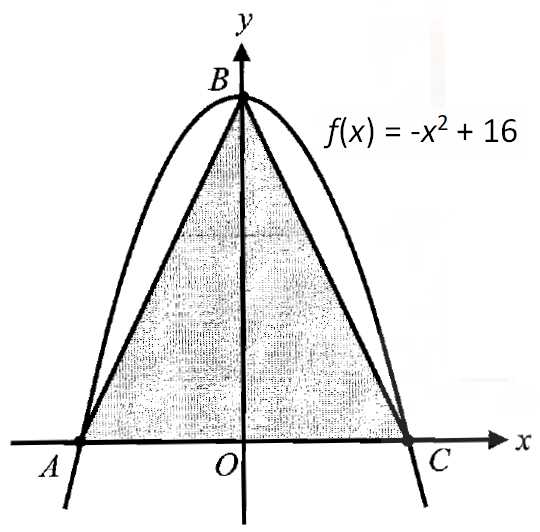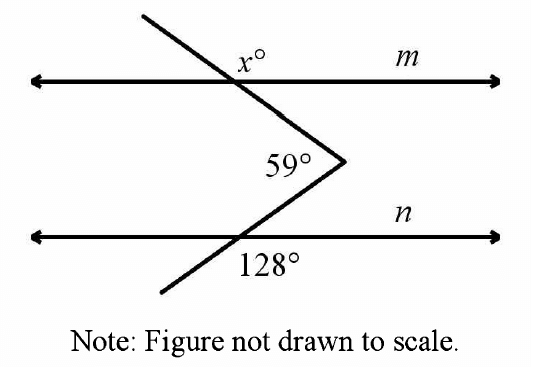MANIPULATING AND SOLVING EQUATIONS
Question 1 :
If
(x - 2)2 + (y - 3)2 + (z + 4)2 = 0,
find the value of (x + y + z).
Answer :
In the equation (x - 2)2 + (y - 3)2 + (z + 4)2 = 0, on the left side, we have the addition of squares of three binomials.
The square of each binomial can never be a negative value.
The only option to get zero for the addition of the squares of three binomials is that the value of square of each binomial must be zero.
(x - 2)2 = 0
x - 2 = 0
x = 2
(y - 3)2 = 0
x - 3 = 0
y = 3
(z + 4)2 = 0
z + 4 = 0
z = -4
x + y + z = 2 + 3 + (-4)
= 5 - 4
= 1
Question 2 :
x3 - 3x2 + 3x - 9 = 0
For what real value of x is the equation above true?
Answer :
x3 - 3x2 + 3x - 9 = 0
We can factor and solve the above equation by grouping.
x2(x - 3) + 3(x - 3) = 0
(x - 3)(x2 + 3) = 0
x - 3 = 0 or x2 + 3 = 0
|
x - 3 = 0 x = 3 (Real) |
x2 + 3 = 0 x2 = -3 x2 = √-3 (Imaginary) |
When x = 3 (real value), the given equation is true.
Question 3 :
If x/5 = k/y, where k is a constant, and y = 3 when x = 10, what is the value of y when x = 2?
Answer :
x/5 = k/y
It is given that y = 3 when x = 10.
10/5 = k/3
2 = k/3
6 = k
Then the given equation is
x/5 = 6/y
Substitute x = 2.
2/5 = 6/y
Take reciprocal on both sides.
5/2 = y/6
Multiply both sides by 6.
15 = y
The value of y is 15 when x = 2.
Question 4 :
If √x + √y = 4√y, where x > 0 and y > 0, what is x in terms of y?
Answer :
√x + √y = 4√y
Subtract √y from both sides.
√x = 3√y
Squaring both sides.
(√x)2 = (3√y)2
x = 32(√y)2
x = 9y
Question 5 :
If xy = 5, which of the following CANNOT be a value for x?
A) -6
B) -5
C) 0
D) 1
Answer :
In the given options, we have the value zero in option (C).
x can not be 0. Because anything multiplied by 0 is 0, it doesn't matter what y is.
Question 6 :
x2 + kx + 9 = (x + a)2
In the equation above, k and a are positive constants. If the equation is true for all values of x, find the value of k.
Answer :
x2 + kx + 9 = (x + a)2
x2 + kx + 9 = (x + a)(x + a)
x2 + kx + 9 = x2 + ax + ax + a2
x2 + kx + 9 = x2 + 2ax + a2
When two expressions are equal, the coefficients of like terms also must be equal.
Equate the coefficients of x-terms and constants.
|
k = 2a Substitute a = 3. k = 2(3) k = 6 |
√a2 = √9 a = ± 3 Since 'a' is positive, a = 3 |
Question 7 :
If
x/2 - x/3 = 1 + 1/2,
what is the value of x?
Answer :
x/2 - x/3 = 1 + 1/2
In the above equation, we have fractions with the denominators 2 and 3.
Least common multiple of the denominators ( 2 and 3) = 6.
Multiply both sides of the equation by 6 to get rid of the denominators.
6(x/2 - x/3) = 6(1 + 1/2)
Using distributive property,
6(x/2) - 6(x/3) = 6(1) + 6(1/2)
3x - 2x = 6 + 3
x = 9
Question 8 :
E = (P - N)/(P + N)
The net effective charge between two particles as a proportion of total charge is represented by E in the formula above, where P is the magnitude of the positive charge N is the magnitude of the negative charge. Which of the following expresses N in terms of P and L?
A) N = EP/(E - 1)
B) N = EP/(E + 1)
C) N = (P + EP)/(E - 1)
D) N = (P - EP)/(E + 1)
Answer :
E = (P - N)/(P + N)
Multiply both sides by (P + N).
E(P + N) = P - N
EP + EN = P - N
Add E to both sides.
EP + EN + N = P
Subtract EP from both sides.
EN + N = P - EP
N(E + 1) = P - EP
Divide both sides by (E + 1).
N = (P - EP)/(E + 1)
The correct answer choice is (D) N = (P - EP)/(E + 1).
Question 9 :
T = 2π√(L/9.8)
The time it takes a clock pendulum to repeat its motion is called its period. The formula above shows the relationship between T, the period of the pendulum in seconds, L, the length of the pendulum in meters. Which of the following is closest to L when T is 8?
A) 14.4
B) 15.9
C) 16.3
D) 17.1
Answer :
T = 2π√(L/9.8)
Substitute T = 8.
8 = 2π√(L/9.8)
Divide both sides by 2π.
8/2π = √(L/9.8)
4/π = √(L/9.8)
Squaring both sides.
(4/π)2 = [√(L/9.8)]2
16/π2 = L/9.8
Multiply both sides by 9.8.
9.8(16/π2) = L
156.8/π2 = L
L ≈ 15.9
The correct answer choice is (B) 15.9.
Question 10 :
C = 100 + 36/n
A boutique shop is selling handmade necklaces. The cost per necklace C can be determined by the equation above, where n is the number of necklaces made.
(a) What is the cost of making 6 necklaces now?
(b) If the shop sells each necklace for $150, how many necklaces should be made so that the shop makes a total profit of $564 after all of them are sold?
Answer :
Part (a) :
C = 100 + 36/n
'C' stands for cost of one necklace.
Please be careful, if you substitute n = 6, you wont get the cost of 6 necklaces, you will get the cost of one necklace when you make 6 necklaces.
Substitute n = 6 in the above equation.
C = 100 + 36/6
= 100 + 6
= 106
When you make 6 necklaces, the cost of one necklace is $106.
The cost of making 6 necklaces :
= 6 x 106
= $636
Part (b) :
Let x be the number of necklaces to be made to make a total profit of $564.
Cost of one necklace when x number of necklaces are made :
C = 100 + 36/x
Total cost of x necklaces :
= x(100 + 36/x)
Using distributive property,
= 100x + 36
Selling price of one necklace = $150 (given).
Total revenue earned when x number necklaces sold :
= 150x
Profit equation :
Total revenue - Total cost = Profit
150x - (100x + 36) = 564
150x - 100x - 36 = 564
50x - 36 = 564
Add 36 to both sides.
50x = 600
Divide both sides by 50.
x = 12
12 necklaces should be made and sold to make a total profit of $564.
Kindly mail your feedback to v4formath@gmail.com
We always appreciate your feedback.
©All rights reserved. onlinemath4all.com
Recent Articles
-
Digital SAT Math Problems and Solutions (Part - 143)
Apr 13, 25 12:01 PM
Digital SAT Math Problems and Solutions (Part - 143) -
Quadratic Equation Problems with Solutions
Apr 12, 25 08:21 PM
Quadratic Equation Problems with Solutions -
Digital SAT Math Problems and Solutions (Part - 142)
Apr 11, 25 06:26 PM
Digital SAT Math Problems and Solutions (Part - 142)

